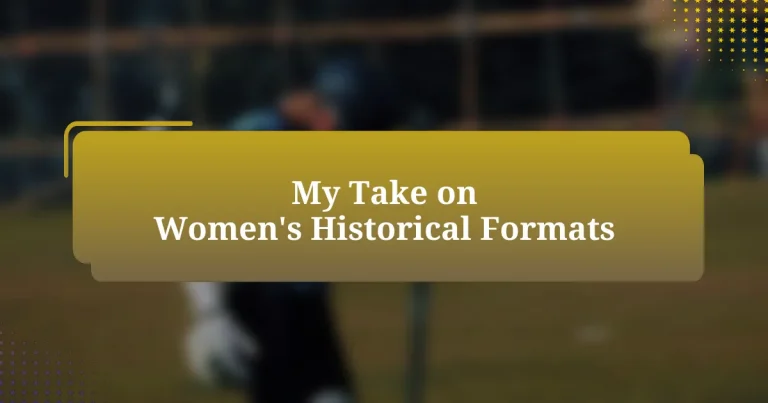Key takeaways:
- Women’s cricket formats have evolved from informal matches in the late 19th century to established competitive formats, including Tests, ODIs, and T20s.
- The T20 format has significantly increased the visibility and popularity of women’s cricket, attracting younger audiences and promoting gender equality in sports.
- The inaugural Women’s ODI World Cup in 1973 marked a revolutionary moment, enhancing the recognition and appeal of women’s cricket through increased broadcasting.
- Future developments may include mixed-gender formats and more professional women’s leagues, potentially transforming the landscape and audience engagement in women’s cricket.
Author: Evelyn Hartwell
Bio: Evelyn Hartwell is a contemporary fiction author known for her poignant storytelling and richly drawn characters. With a background in psychology, she explores the intricacies of human emotions and relationships in her novels. Her work has been featured in several literary magazines and anthologies, earning accolades for its depth and insight. When she’s not writing, Evelyn enjoys hiking in the mountains and nurturing her passion for photography. She lives in Asheville, North Carolina, with her two rescue dogs and a stack of well-loved books.
Overview of women’s cricket formats
Women’s cricket formats have evolved significantly over the years, reflecting the growth and recognition of female athletes in the sport. I remember my first encounter with a women’s T20 match; the energy was palpable, and it truly showcased the fast-paced nature of this format. It’s fascinating how T20 matches, with their thrilling finishes, have become a favorite among both players and fans alike.
In addition to T20, the 50-over ODI format plays a crucial role in women’s cricket, offering teams the chance to strategize over a longer period. I think back to watching the 2017 Women’s World Cup, where the ODI format allowed for some of the most memorable comebacks in cricket history. Isn’t it amazing how a single match can change the trajectory of a player’s career and inspire a new generation of girls to take up the sport?
Moreover, the traditional Test format provides a unique opportunity for women to showcase their skills in a longer format that truly tests endurance and strategy. When I’ve chatted with players, they often express a sense of pride in representing their countries in Tests. Doesn’t it resonate deeply when athletes get the chance to write their legacies in five-day matches, pushing the boundaries of what women’s sport can achieve?
Definition of cricket formats
Cricket formats are essentially the different structures in which the game is played, each with its own set of rules and durations. I remember attending a local match where a mix of formats created an electric atmosphere, and it struck me how each format brings its own flavor to the game. For instance, the T20 format emphasizes quick scoring and entertainment, making every ball count in a way that’s quite unique.
The 50-over One Day International (ODI) format, on the other hand, strikes a balance between strategy and pace. Watching my favorite female cricketers navigate through the innings really made me appreciate how players adapt their game plans based on the format. It’s intriguing how the rhythm of the match changes—do you feel the same tension build as the overs wind down, especially in nail-biting finishes?
Then there’s the Test format, which stands as a testament to the sport’s rich heritage. I recall a conversation with a veteran player who spoke about the sheer satisfaction of playing a five-day match. It made me reflect on the stories that emerge over those days—are they not the heartbeats of cricket history? The diverse formats allow players to express their skills differently, shaping the landscape of women’s cricket in profound ways.
Historical evolution of women’s cricket
The journey of women’s cricket has been both inspiring and transformative. From its modest beginnings in the late 19th century, where women played informal matches, to the establishment of competitive formats, it has come a long way. I often think back to those early games I read about, where women were seen as pioneers, breaking societal norms just to play the sport they loved.
As I delve into the 1970s and 1980s, it’s fascinating to see how the Women’s World Cup emerged. I remember the thrill of watching those matches as a child; it was like witnessing history unfold. Growing up, I often wondered what it must have been like for those players to be trailblazers, pushing boundaries while fighting for recognition in a predominantly male sport.
Fast forward to the present, and the evolution of T20 formats has changed everything. I recall attending a women’s T20 match that was filled with excitement and energy. The athletes showcased their incredible talent under the spotlight, and I realized how crucial this format has been in pulling a younger audience towards the game. With each match, I could see new possibilities unfolding, making me ponder—what does the future hold for women’s cricket?
Key formats in women’s cricket
The key formats in women’s cricket primarily revolve around three main types: Test matches, One Day Internationals (ODIs), and T20s. Test matches, with their rich history, allow for strategic gameplay and longer narratives on the field, often deeply testing players’ skills and stamina. I remember catching a thrilling Test match on television, where the tension mounted each day; it felt as if I was part of something profound, watching a sport rooted in tradition.
One Day Internationals hold a special place in my heart, especially witnessing the 50-over World Cup. The drama of quick runs and skilled bowling kept me glued to my seat. I often think how this format balances the excitement of limited overs with the strategy similar to Tests, creating a captivating spectacle that draws both casual and dedicated fans.
T20 cricket, on the other hand, is an energetic whirlwind of talent and competition. I vividly recall attending a local T20 league match, where young girls cheered enthusiastically for their role models. This format has invigorated women’s cricket, offering a platform where athleticism and entertainment meet. It makes me wonder—how many future stars are out there chasing their dreams, inspired by these very games?
Comparison of formats in history
The historical evolution of women’s cricket formats reveals a distinct journey shaped by societal changes and sporting advancements. When examining Test matches, I recall hearing stories from female players who fought for recognition on the field. Their resilience echoed the sentiments of many women athletes, striving for equality in a sport that was often deemed a man’s game.
As I reflect on ODIs, I can’t help but think about the era when these matches first started gaining traction. I remember the excitement in the air during the inaugural women’s ODI World Cup in 1973; it felt revolutionary. The pivotal role of broadcasting during this time helped elevate women’s cricket, and I often wonder how many casual viewers became lifelong fans after witnessing those exhilarating matchups.
T20 formats dramatically shifted the landscape for women’s cricket, making it accessible and appealing to a younger demographic. I think back to a vibrant festival I attended where families crowded the stands, enjoying the fast-paced nature of the games. It’s fascinating to consider how T20 has not only broadened the fanbase but also paved the way for sponsorships and increased visibility – a game-changer in the quest for gender equality in sports.
My personal experiences with formats
My journey with the different formats of women’s cricket has been both enlightening and inspiring. When I attended a women’s Test match for the first time, I was struck by the sheer determination on the players’ faces. Watching them bat for hours, I felt a profound connection to their struggle for recognition in a historical format where their efforts were often overlooked. How could such tenacity not be celebrated?
Reflecting on one of the early women’s ODI matches I caught on TV, the energy was palpable. I vividly remember cheering for my favorite player, completely unaware of how significant it was at the time. That match ignited a spark in me—a realization of belonging to something greater than just a sport. It was a reminder that we were witnessing history in the making, where every swing of the bat resonated with countless struggles for equality.
Then I recall my first experience attending a T20 match. The atmosphere was electric, and the thrill of the fast-paced game was contagious. I had never seen so many families enjoying cricket together, and I realized this format had transformed women’s cricket into a celebration for everyone. It left me contemplating how this newfound accessibility can inspire the next generation of female cricketers. Who wouldn’t want to be part of such an exciting evolution?
Future of women’s cricket formats
The future of women’s cricket formats holds immense potential for growth and innovation. I envision more franchises adopting the women’s T20 format, akin to how the men’s leagues have flourished. This could create a new wave of enthusiasm, bringing more visibility and financial support to women cricketers. Have you ever thought about how a league could elevate the game?
As I reflect on the conversations I’ve had with young cricketers, there’s a palpable excitement about the development of mixed-gender formats. The idea of watching a co-ed tournament could usher in a fresh dynamic, breaking down barriers and stereotypes surrounding the sport. It’s fascinating to consider how these changes could inspire not only players but also fans. Wouldn’t that foster a deeper appreciation for the game across all genders?
Equally, I believe international boards will start to prioritize women’s formats in major tournaments, similar to how they treat their male counterparts. Picture this: an annual global women’s T20 series drawing in diverse crowds and creating rivalries that fans adore. This focus would further push women’s cricket into the spotlight, allowing fans to connect with players and their journeys. Isn’t that the essence of sports—to build connections that transcend boundaries?



